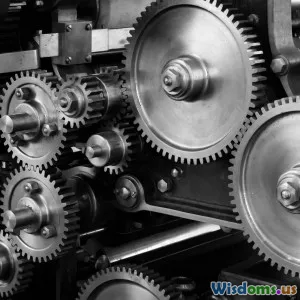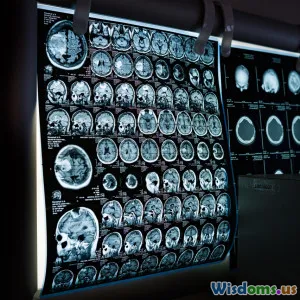
Ten Unexpected Uses for Robotics in Everyday Life
9 min read Explore ten surprising ways robots improve daily life, enhancing convenience, health, and creativity beyond traditional boundaries. (0 Reviews)
Ten Unexpected Uses for Robotics in Everyday Life
Robotics technology has long been associated with factory floors, futuristic labs, and science fiction. However, in recent years, robots have stealthily woven themselves into the fabric of everyday human life in ways that many might find surprising. Far from just industrial automatons, these adaptable machines are now personal assistants, caregivers, environmental stewards, and even creative partners. In this article, we'll explore ten unexpected uses for robotics that are transforming the mundane into the extraordinary.
1. Robotic Companions in Personalized Education
Education is becoming increasingly individualized, and robots are playing a vital role. Educational robots like "Cozmo" and "Miko" cater to children's learning styles by engaging them through interactive play and providing instant feedback, which enhances motivation and retention.
In classrooms, robots such as "Nao" act as tutors for language learning and social skills, especially for children with autism spectrum disorder. According to a 2020 study in Frontiers in Robotics and AI, robot-assisted therapy improved engagement and communication skills in autistic children by over 50% compared to traditional methods.
These robotic companions create dynamic learning experiences outside the standard textbook approach, offering educators invaluable tools.
2. Autonomous Crop Monitoring and Pest Control
Agriculture traditionally relies on intensive manual labor and pesticide use, which can be costly and environmentally damaging. Robotics innovations have introduced autonomous drones and ground-based robots that monitor crops with precision.
Robots equipped with multispectral imaging cameras detect plant health issues early, identifying nutrient deficiencies or disease before visible symptoms appear. The "Ecorobotix" weed control robot sprays herbicides precisely on weeds rather than blanket applications, reducing chemical usage by up to 90%.
According to the Food and Agriculture Organization (FAO), integrating robotics can reduce food waste by enhancing crop yields while promoting sustainable farming practices.
3. Advanced Home Assistance for the Elderly
Robotics is revolutionizing eldercare beyond basic assistance. Robots like "Paro," a therapeutic robot seal, provide emotional support for patients with dementia, reducing anxiety and depression.
Meanwhile, service robots such as "Care-O-Bot" perform tasks like medication reminders, fall detection, and even help with mobility, enabling seniors to live independently longer. A 2019 survey by the International Federation of Robotics found that 42% of elderly respondents reported improved quality of life when assisted by home robots.
Such technology not only elevates care standards but also relieves the burden on human caregivers.
4. Creative Collaborations in Art and Music
Robots are entering the creative domain, traditionally considered a human-exclusive territory. Machines like "The Painting Fool" and "Ai-Da," a humanoid robot artist, create original artworks using AI algorithms and robotic limbs.
In music, robots such as "Shimon," developed by Georgia Tech, compose and perform jazz improvisations in real time alongside human musicians. These developments challenge notions of creativity and inspire new artistic possibilities.
This emerging trend highlights robotics' role in augmenting human creativity rather than replacing it.
5. Environmental Clean-Up and Monitoring
From oceans to urban parks, robots assist in environmental preservation with tasks difficult or dangerous for humans.
The "WasteShark" drone autonomously collects floating debris on waterways, preventing pollution from reaching oceans. Similarly, autonomous drones monitor air and water quality in real time, providing data that inform policy and conservation efforts.
Such robotic applications improve ecosystems' health, highlighting technology’s role in addressing global environmental challenges.
6. Precision Cooking and Food Preparation
Imagine a robot that not only chops vegetables with perfect precision but also cooks intricate recipes replicating expert chefs’ techniques.
Robotic kitchen assistants like "Flippy" automate burger flipping and frying tasks, increasing consistency and hygiene in fast-casual dining. "Moley Robotics" created a robotic kitchen system capable of preparing over 100 recipes.
According to a report by Allied Market Research, the smart kitchen robots market is projected to grow at a CAGR of 25% over the next five years, driven by demand for convenience and food quality.
Robotic culinary assistants offer time-saving advantages while elevating home cooking experiences.
7. Personalized Fitness and Physical Therapy
Robots are personal trainers and therapists that provide adaptive workouts and meticulous rehabilitation.
Exoskeletons like "ReWalk" assist individuals with mobility impairments by enabling walking and improved posture. Similarly, systems such as "Kangas Robotics" deliver physical therapy exercises tailored to patient progress, capturing data to optimize recovery.
Fitness robots equipped with AI offer real-time coaching by analyzing biomechanics and adjusting routines.
These technologies democratize physical health by making expert-level care and training more accessible and measurable.
8. Smart Cleaning Robots Beyond Vacuuming
While robotic vacuum cleaners are well-known, the cleaning robot landscape is vastly expanding.
Robots like "RoboScrub" and "AquaBot" specialize in floor scrubbing, window cleaning, and pool maintenance, performing chores that are physically demanding or hazardous.
Leveraging AI, these robots can map complex environments, adapt to varying surfaces, and perform cleaning routines autonomously, which saves time and effort.
With urban lifestyles increasingly busy, smart cleaning robots contribute significantly to household management.
9. Robotic Pet Care
Robotics extends even to pet care, innovating how we interact with and care for animals.
Automated feeders like "PetSafe Smart Feed" regulate meal portions, while robots like "Pawbo+" allow remote interaction, including treat dispensing and video chats with pets during the owner's absence.
Additionally, robotic litter boxes employ sensors to maintain hygiene proactively.
These tools promote healthy pets and peace of mind for owners balancing work and life pressures.
10. Disaster Response and Rescue Operations
Robots are invaluable in high-risk situations where human rescue workers may face peril.
Unmanned ground vehicles (UGVs) and drones traverse rubble in earthquake zones or hazardous environments collecting crucial information, locating survivors, and delivering supplies.
For example, the robot "PackBot" was deployed during the Fukushima nuclear disaster to assess radiation levels where humans could not enter safely.
Advancements in robotic mobility and AI decision-making continue to improve the effectiveness and safety of disaster response efforts.
Conclusion
Robotics technology has transcended traditional industrial applications, quietly revolutionizing numerous facets of daily life in unexpected ways. From enhancing education and healthcare to fostering creativity and environmental stewardship, robots contribute to improved quality of life with efficiency and innovation.
As robotic capabilities continue advancing through AI and sensor integration, the scope of impact will expand, inviting us to reconsider how we engage with technology in our homes, communities, and workplaces.
Embracing these robotic innovations not only augments human potential but also addresses pressing societal challenges — making everyday life safer, smarter, and more fulfilling.
Takeaway
Whether you’re an educator, gardener, artist, or caregiver, exploring these robotic applications can inspire transformative changes. Staying informed and open to integrating robotic assistance will empower us all to harness technology’s full benefits in everyday living.
By blending creative potential with practical needs, robotics is reshaping what ‘ordinary life’ means — often in surprisingly remarkable ways.
Rate the Post
User Reviews
Popular Posts
















